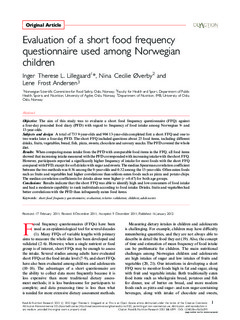| dc.contributor.author | Lillegaard, Inger Therese | |
| dc.contributor.author | Øverby, Nina Cecilie | |
| dc.contributor.author | Andersen, Lene Frost | |
| dc.date.accessioned | 2012-04-24T09:02:02Z | |
| dc.date.available | 2012-04-24T09:02:02Z | |
| dc.date.issued | 2012 | |
| dc.identifier.citation | Lillegaard, I. T. L., Øverby, N. C., & Andersen, L. F. (2012). Evaluation of a short food frequency questionnaire used among Norwegian children. Food & Nutrition Research, 56: 6399. | no_NO |
| dc.identifier.issn | 1654-6628 | |
| dc.identifier.uri | http://hdl.handle.net/11250/139013 | |
| dc.description.abstract | Objective: The aim of this study was to evaluate a short food frequency questionnaire (FFQ) against a four-day precoded food diary (PFD) with regard to frequency of food intake among Norwegian 9- and 13-year-olds.
Subjects and design: A total of 733 9-year-olds and 904 13-year-olds completed first a short FFQ and one to two weeks later a four-day PFD. The short FFQ included questions about 23 food items, including different drinks, fruits, vegetables, bread, fish, pizza, sweets, chocolate and savoury snacks. The PFD covered the whole diet.
Results: When comparing mean intake from the PFD with comparable food items in the FFQ, all food items showed that increasing intake measured with the PFD corresponded with increasing intake with the short FFQ. However, participants reported a significantly higher frequency of intake for most foods with the short FFQ compared with PFD, except for soft drinks with sugar and sweets. The median Spearman correlation coefficient between the two methods was 0.36 among the 9-year-olds and 0.32 among the 13-year-olds. Often eaten foods such as fruits and vegetables had higher correlations than seldom eaten foods such as pizza and potato chips. The median correlation coefficients for drinks alone were higher (r0.47) for both age groups.
Conclusions: Results indicate that the short FFQ was able to identify high and low consumers of food intake and had a moderate capability to rank individuals according to food intake. Drinks, fruits and vegetables had better correlations with the PFD than infrequently eaten food items. | no_NO |
| dc.language.iso | eng | no_NO |
| dc.publisher | Swedish Nutrition Foundation | no_NO |
| dc.rights | Navngivelse-Ikkekommersiell 4.0 Internasjonal | |
| dc.rights.uri | http://creativecommons.org/licenses/by-nc/4.0/deed.no | |
| dc.subject | children, evaluation, relative validation, short food frequency questionnaire | no_NO |
| dc.title | Evaluation of a short food frequency questionnaire used among Norwegian children | no_NO |
| dc.type | Journal article | no_NO |
| dc.type | Peer reviewed | no_NO |
| dc.rights.holder | © 2012 The Author(s) | |
| dc.subject.nsi | VDP::Medical disciplines: 700::Health sciences: 800 | no_NO |
| dc.source.pagenumber | 9 | no_NO |
| dc.source.volume | 56 | no_NO |
| dc.source.journal | Food & Nutrition Research | no_NO |
| dc.source.issue | 1 | no_NO |
| dc.identifier.doi | https://doi.org/10.3402/fnr.v56i0.6399 | |
| dc.source.articlenumber | 6399 | |

